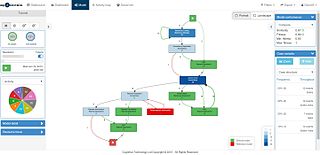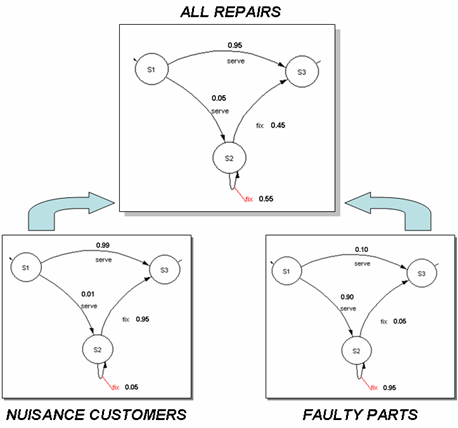
A Petri net, also known as a place/transition (PT) net, is one of several mathematical modeling languages for the description of distributed systems. It is a class of discrete event dynamic system. A Petri net is a directed bipartite graph that has two types of elements: places and transitions. Place elements are depicted as white circles and transition elements are depicted as rectangles. A place can contain any number of tokens, depicted as black circles. A transition is enabled if all places connected to it as inputs contain at least one token. Some sources state that Petri nets were invented in August 1939 by Carl Adam Petri—at the age of 13—for the purpose of describing chemical processes.

An event-driven process chain (EPC) is a type of flow chart for business process modeling. EPC can be used to configure enterprise resource planning execution, and for business process improvement. It can be used to control an autonomous workflow instance in work sharing.

Business Process Model and Notation (BPMN) is a graphical representation for specifying business processes in a business process model.
A workflow pattern is a specialized form of design pattern as defined in the area of software engineering or business process engineering. Workflow patterns refer specifically to recurrent problems and proven solutions related to the development of workflow applications in particular, and more broadly, process-oriented applications.

The XML Process Definition Language (XPDL) is a format standardized by the Workflow Management Coalition (WfMC) to interchange business process definitions between different workflow products, i.e. between different modeling tools and management suites. XPDL defines an XML schema for specifying the declarative part of workflow / business process.
Sequential pattern mining is a topic of data mining concerned with finding statistically relevant patterns between data examples where the values are delivered in a sequence. It is usually presumed that the values are discrete, and thus time series mining is closely related, but usually considered a different activity. Sequential pattern mining is a special case of structured data mining.
Process mining is a family of techniques relating the fields of data science and process management to support the analysis of operational processes based on event logs. The goal of process mining is to turn event data into insights and actions. Process mining is an integral part of data science, fueled by the availability of event data and the desire to improve processes. Process mining techniques use event data to show what people, machines, and organizations are really doing. Process mining provides novel insights that can be used to identify the execution paths taken by operational processes and address their performance and compliance problems.
A program structure tree (PST) is a hierarchical diagram that displays the nesting relationship of single-entry single-exit (SESE) fragments/regions, showing the organization of a computer program. Nodes in this tree represent SESE regions of the program, while edges represent nesting regions. The PST is defined for all control flow graphs.

In systems engineering, software engineering, and computer science, a function model or functional model is a structured representation of the functions within the modeled system or subject area.
Business process management (BPM) is the discipline in which people use various methods to discover, model, analyze, measure, improve, optimize, and automate business processes. Any combination of methods used to manage a company's business processes is BPM. Processes can be structured and repeatable or unstructured and variable. Though not required, enabling technologies are often used with BPM.

Willibrordus Martinus Pancratius van der Aalst is a Dutch computer scientist and full professor at RWTH Aachen University, leading the Process and Data Science (PADS) group. His research and teaching interests include information systems, workflow management, Petri nets, process mining, specification languages, and simulation. He is also known for his work on workflow patterns.
Fraud represents a significant problem for governments and businesses and specialized analysis techniques for discovering fraud using them are required. Some of these methods include knowledge discovery in databases (KDD), data mining, machine learning and statistics. They offer applicable and successful solutions in different areas of electronic fraud crimes.
The α-algorithm or α-miner is an algorithm used in process mining, aimed at reconstructing causality from a set of sequences of events. It was first put forward by van der Aalst, Weijters and Măruşter. The goal of Alpha miner is to convert the event log into a workflow-net based on the relations between various activities in the event log. An event log is a multi-set of traces, and a trace is a sequence of activity names. Several extensions or modifications of it have since been presented, which will be listed below.
Artifact-centric business process model represents an operational model of business processes in which the changes and evolution of business data, or business entities, are considered as the main driver of the processes. The artifact-centric approach, a kind of data-centric business process modeling, focuses on describing how business data is changed/updated, by a particular action or task, throughout the process.

Business process conformance checking is a family of process mining techniques to compare a process model with an event log of the same process. It is used to check if the actual execution of a business process, as recorded in the event log, conforms to the model and vice versa.
In business analysis, the Decision Model and Notation (DMN) is a standard published by the Object Management Group. It is a standard approach for describing and modeling repeatable decisions within organizations to ensure that decision models are interchangeable across organizations.
Inductive miner belongs to a class of algorithms used in process discovery. Various algorithms proposed previously give process models of slightly different type from the same input. The quality of the output model depends on the soundness of the model. A number of techniques such as alpha miner, genetic miner, work on the basis of converting an event log into a workflow model, however, they do not produce models that are sound all the time. Inductive miner relies on building a directly follows graph from event log and using this graph to detect various process relations.
Process mining is a technique used to turn event data into insights and actions. Techniques used in process mining such as Process discovery and Conformance checking depend only one the order of activities executed in the operations. The event log not only contains the activity details, but also timestamps, resources and data accompanied with process execution. Careful analysis of the external details from the event log can reveal useful information that can be used for making predictions on decisions that might be taken in the future, efficiency and working dynamics of the team, and performance analysis.
Streaming conformance checking is a type of doing conformance checking where the deviation is reported directly when it happens. Instead of event log, streaming conformance checking techniques take event stream and process model as input and for each received event from the stream, it will be compared with the model.
Token-based replay technique is a conformance checking algorithm that checks how well a process conforms with its model by replaying each trace on the model. Using the four counters produced tokens, consumed tokens, missing tokens, and remaining tokens, it records the situations where a transition is forced to fire and the remaining tokens after the replay ends. Based on the count at each counter, we can compute the fitness value between the trace and the model.








